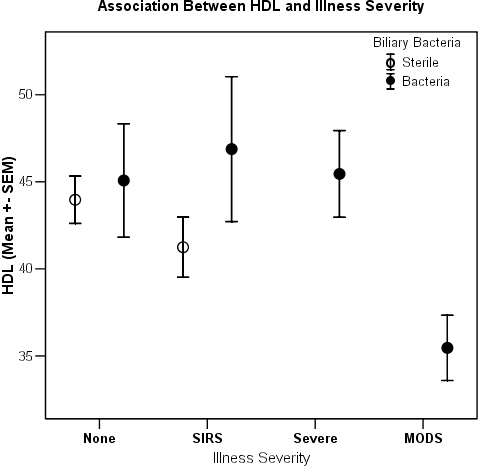|
|
Back to Annual Meeting Program Plasma Lipids and Biliary Infections: Decreased Levels of HDL Are Associated With More Severe Biliary Infections: a Multivariate Analysis Lygia Stewart*1,2, Gary Jarvis3, Lawrence Way1 1Surgery, UCSF, San Francisco, CA; 2Surgery, SF VA Medical Center, San Francisco, CA; 3Infectious Disease and Laparotory Medicine, SF VA Medical Center, San Francisco, CA
We, and others, have previously identified factors associated with severe biliary infections: biliary bacteria, age, sex, choledocholithiasis, pigment stones. Recently we reported that a low/normal BMI was associated with more severe biliary infections. To understand this association, we studied correlations between plasma lipid levels and biliary infections. METHODS: 475 patients with gallstones were studied; 410 men, 65 women; average age 62 (range 17-104). Gallstones, bile, and blood(as applicable) were cultured, Stone type recorded. Illness severity was classified as: none (no inflammatory manifestations), SIRS (fever, leukocytosis), severe (abscess, cholangitis, empyema), or MODS (bacteremia, hypotension, organ failure). Using bivariate and multivariate analysis, we examined associations between lipid levels (HDL, LDL, Triglycerides - obtained prior to the acute illness) and: BMI, biliary bacteria, bacteremia, gallstone type, illness severity. In the multivariate analysis we used factors associated with biliary infections (age, sex, biliary bacteria, pigment stones, choledocholithiasis). RESULTS: On bivariate analysis(Table), BMI correlated with HDL and Trig (P<0.003). LDL inversely correlated with biliary bacteria (P=0.002) and pigment stones (P=0.0001); while HDL and LDL inversely correlated with bacteremia (P<0.03). HDL and LDL inversely correlated with increasing infection severity (P<0.02) and MODS manifestations (P<0.006). On Multivariate analysis of factors associated with pigment stones and biliary bacteria, LDL inversely correlated with pigment stones (P=0.001) and biliary bacteria (P=0.017). Multivariate analysis of factors associated with biliary infection severity revealed HDL as the most important lipid(Figure); only HDL inversely independently correlated with biliary infection severity(P=0.007) and MODS manifestations(P=0.005). These findings held in the subgroup with biliary bacteria; and HDL independently correlated with illness severity even among patients with bacterial-laden CBD stones. CONCLUSION: This study demonstrates the importance of plasma lipids to biliary infections. Increased LDL levels favored cholesterol (rather than pigment) gallstone formation, and were more often associated with a sterile biliary tract. HDL levels, however, seemed to dictate the course of the biliary infection; patients with low HDL levels had significantly more severe biliary infections. Even among patients with bacterial-laden CBD stones, those with high HDL levels had a mild illness, while those with low HDL levels more often had MODS manifestations. This data suggest that HDL may be protective in biliary infections; and that patients with biliary infections and low HDL levels may need a more aggressive clinical approach. This is the first study to demonstrate the importance of plasma lipid levels to the severity of biliary infections.

Back to Annual Meeting Program
|
||||||||||||||||||||||||||||||||||||||||||||||||||||||||||||||||||||||||||||||||||||||
© 2025 Society for Surgery of the Alimentary Tract. All Rights Reserved. Read the Privacy Policy.

